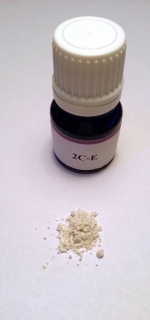2C-E: Difference between revisions
Dumbdumb123 (talk | contribs) m (Goodbye moonmen) |
Dumbdumb123 (talk | contribs) m (Goodbye moonmen) |
||
| Line 52: | Line 52: | ||
Note: The prevalence of negative effects increases with higher doses. | Note: The prevalence of negative effects increases with higher doses. | ||
=== Negative === | === Negative === | ||
Revision as of 16:51, 9 October 2018

2C-E is a chemical of the 2C-X series which is characterised by its particularly intense visuals and higher potency when compared with other members of the family.
History
2C-E, like many of its close analogues, was first synthesized by Alexander Shulgin and published in PiHKAL. He was quite fond of it, granting it a place in his "Magical Half Dozen" alongside of DOM, 2C-B, 2C-T-2 & 7 and mescaline.
Usage
2C-E is mainly a recreational entheogen. It can be quite introspective in appropriate doses and settings. It doesn't lend itself well to intense party-like surroundings, much like LSD or similarly intense psychedelics.
Dosage
{{#tdose: 2ce }}
Duration
Note: Duration can be significantly longer with higher doses.
Anecdotal evidence has shown the oral onset of 2C-E may vary wildly for some users, taking up to three hours before first effects in some cases.
| Onset | 60-90 minutes |
| Total | 9-14 hours |
| Onset | 20-40 minutes |
| Total | 6-9 hours |
Effects
2C-E is a psychedelic phenethylamine and as such has psychedelic and stimulant effects. As with all psychedelics, different users are likely to experience different sets of effects, which usually include some however very rarely would include all of the following effects.
Compared to other members of the 2C-X family, 2C-E is generally considered to have a heavier body load and to be more visual than its counterparts.
Note: The prevalence of negative effects increases with higher doses.
Negative
- Tension
- Anxiety, restlessness, confusion
- Dizziness
- Nausea, gastrointestinal discomfort, possible vomiting
- Over-sensitivity to music or other sensory stimuli
- Unwanted 'spiritual' experiences
- Racing thoughts
Harm Reduction
- As with all psychedelic drugs 2C-E carries with it the potential for a very powerful experience, and as such has the potential to create a very difficult experience ('bad' trip). Mindset and setting play important roles in governing the nature of a psychedelic experience, among other things.
See Psychedelic Harm Reduction for more information.
- As with all stimulants, care should be taken when dosing via different ROAs. The oral route has a much lower bioavailabity than those that bypass first pass metabolism i.e. Insufflated, rectal, intramuscular, intravenous and subcutaneous.
See Stimulant Harm Reduction for more information.
Interactions
See the Drug combinations chart for more information.
Chemistry and Pharmacology
Chemistry
2,5-Dimethoxy-4-ethylphenethylamine is a colorless oil and analogue of mescaline. Similarly it is classified as a psychedelic phenethylamine. It shares the substituted amphetamine core found in the structure of many entactogens. Crystalline forms are obtained as the amine salt by reacting the free base with a mineral acid, typically HCl. It is soluble in both water and ethanol. Maximum concentration in H2O is reported at ~50mg/ml and it is said to be relatively stable in solution. A drop below normal ambient temperatures can cause particles to crystalize out.
Shulgin does not report an exact boiling point for the free base, stating only that during one synthesis the fraction boiling between 90-100 °C at 0.25 mmHg pressure was collected and converted to the hydrochloride salt. Shulgin reports the melting point of the hydrochloride salt as 208.5-210.5 °C.
A full write up on Shulgin's synthesis for 2C-E can be found here.
Pharmacology
Like most psychedelic drugs, 2C-E is a 5-HT2a Agonist; from that, we can presume the concurrent or pre-administration of SSRIs may reduce the effects of 2C-E. 2C-E is one of the most potent of the 2C-X family, behind only 2C-P and 2C-T-4. The 2C-X family, specifically, 2C-E, 2C-I, and 2C-C all stimulated G protein binding, suggesting more of an activity similar to tryptamines such as 5-MeO-DMT and, interestingly, DPT. G Proteins are membrane proteins that effectively mediate interaction between hormone receptors and enzymes responsible for changes of metabolism as a result of hormonal changes.
In rats, Stage I metabolism involved deamination and O-Demthylation, which are related to the Monoamine oxidase (MAO) and cytochrome P450 (CYP) enzymes. For virtually all the 2C’s, (B,I,D,E,T-2, and T-7), MAO-A and MAO-B were reacted upon; interestingly, ½ of the molecules in Shulgin’s Magical Half Dozen (2C-E, 2C-T-2, 2C-T-7, with the addition of 2C-D) also act to a small extent on the CYP2D6 enzyme. Because of the commonality of these receptors, the 2C-X family is likely to be more reactive with other concurrently administered chemicals.
LD50
The LD50 in humans is not currently known. Use caution when exploring high doses of this compound.
Legal status
- In Australia, 2C-E was added to the 'Dangerous Drugs' list of the 'Drugs Misuse Amendment Act 2008.
- In Denmark, 2C-E has been added to the list of Schedule B controlled substances.
- In New Zealand, 2C-E is illegal under the Analogues section of Schedule 3 / Class C, along with 2C-I, DOI, ephedrine and pseudoephedrine.
- In Sweden, 2C-E has been made illegal to sell or possess under their Act on the Prohibition of Certain Goods Dangerous to Health (lagen om förbud mot vissa hälsofarliga varor).
- In the UK, 2C-E is a Class A controlled Substance under the Misuse of Drugs Act's 2002 amendments and as such is illegal to possess to supply.
- In Germany, 2C-E is a Schedule I drug as of late 2014.
- In the USA, 2C-E is a Schedule I substance under the FDA Safety and Innovation act of 2012, and is illegal to possess, distribute or manufacture.